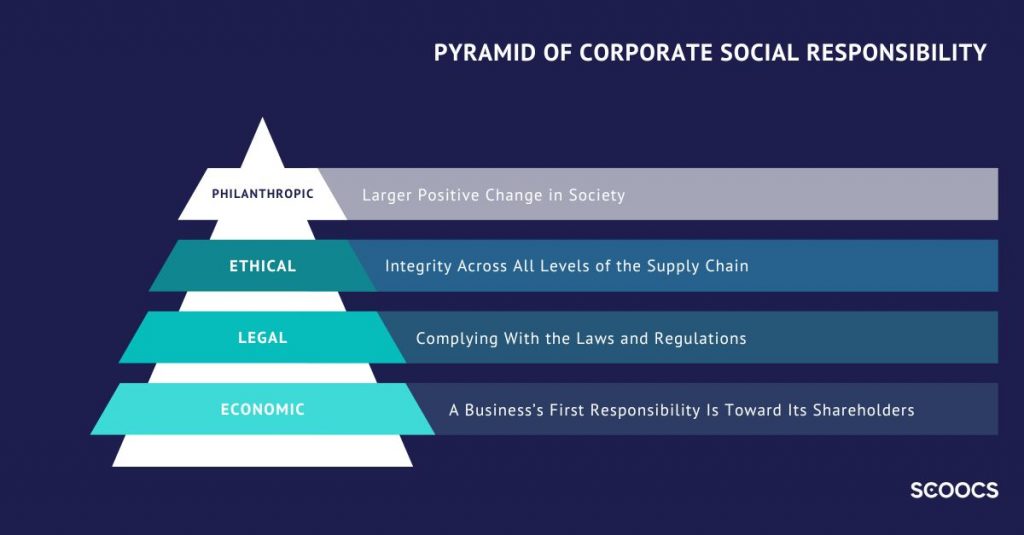The pyramid of corporate social responsibility (CSR) was created in 1979 by Archie Carroll as a model that orders CSR values in a hierarchy that businesses can apply. Carroll’s pyramid has had a profound impact on how industry leaders in the 80s and 90s rethought the role of their businesses. But how relevant are CSR values today and what lessons can the modern businessman derive from the pyramid of corporate social responsibility?
In this article
The Origins of CSR & Carroll’s Pyramid
Why is Carroll’s Pyramid of CSR important?
What are the 4 levels of the CSR Pyramid?
5 world-famous companies committed to CSR

The Origins of CSR and Carroll’s Pyramid
Old Economic Paradigms
The idea of Corporate Social Responsibility (CSR) originates in the 50s and 60s of the 20th century when a growing number of businesses began to consider the social and environmental impact of their operations. Before that point, the leading economic doctrine was expressed by Milton Friedman in his words” “an entity’s greatest responsibility lies in the satisfaction of the shareholders”.
The Silent Revolution of CSR values
However, his view was challenged by other theoreticians who argued that a business should consider the social and environmental impact of its operations and it has a responsibility towards society and the environment. Among them, Howard Bowen is often cited as the ‘father of CSR’.
In the decades that followed, the concept of CSR continued to evolve, with businesses taking on increasingly comprehensive and sophisticated CSR programs. CSR values continued to rise in popularity, reflecting a societal transformation in the West towards post-materialism, also dubbed as ‘the Silent Revolution of Values’ by Inglehart.
Systematizing CSR values
However, CSR was never clearly systematized in a single comprehensive model before Archie Carroll. He is a professor and researcher of CSR at the University of Georgia and has published dozens of publications on the topic. However, he is best remembered for his Pyramid of Corporate Social Responsibility which he created in 1979. Carroll has shared that he had drawn inspiration for the model from Maslow’s hierarchy of needs.

Why is Carroll’s pyramid of CSR important?
It’s a helpful comprehensive framework
Archie Carroll’s Pyramid of Corporate Social Responsibility (CSR) is important because it provides a comprehensive framework for companies to understand and prioritize their social and environmental responsibilities, supports responsible business practices, and has become a widely recognized and widely used tool for companies looking to implement effective CSR programs.
The impacts of the pyramid of CSR
One of the key impacts of the Pyramid of CSR has been to shift the focus of CSR from a purely philanthropic pursuit to a more comprehensive and integrated approach that includes economic, legal, ethical, and philanthropic responsibilities. This shift has helped businesses to see CSR as a strategic and integral part of their operations, rather than just a separate or optional initiative.
The Pyramid of CSR has also had a significant impact on the way businesses think about their role in society and the environment. By outlining specific responsibilities and priorities, the Pyramid of CSR has helped companies to understand and act on their obligations to stakeholders and the broader community.
Criticisms of Carroll’s pyramid of CSR
Although Carroll’s model is usually praised for its clarity and comprehensiveness, it has also attracted a certain amount of criticism. These are notably focused on the model’s limited focus and a one-size-fits-all approach. For example, the model says little about the role of government and society in creating a supportive regulatory and social environment for businesses.
Critics on the business side argue that the Pyramid of CSR is too generic and does not account for the unique circumstances and challenges faced by different businesses in different industries and regions. However, critics on the environmental side blame the model for giving priority to economic concerns over societal and environmental ones.
It’s important to keep in mind that Carroll’s model is not a silver bullet, but it has helped dozens of companies to systematize and prioritize their CSR commitments. Although it’s not as societally orientated as some advocates may like, it is definitely a giant step in the right direction.

What are the 4 levels of the CSR Pyramid?
Carroll’s Pyramid of CSR outlines four distinct levels of responsibilities that businesses have: economic, legal, ethical, and philanthropic. These communicate the responsibility of businesses towards their shareholders, the law, and the people, and to give back to the community and support social and environmental causes.
The Economic Responsibilities of CSR
Carroll argues that a business’s first responsibility is toward its shareholders. As a legal for-profit entity, it needs to generate a profit in order to provide employment opportunities and drive economic growth. Fair and ethical business dealings must provide the economic foundation upon which philanthropic endeavors can be pursued.
Legal Responsibilities in the Pyramid of CSR
The second layer of the pyramid of corporate social responsibility is about complying with the laws and regulations of the location where the business resides. Typical regulations concern work safety, product quality, as well as environmental protection, and harm mitigation.
Ethical Responsibilities in the Pyramid of CSR
The third level in the CSR Pyramid concerns people and company culture. It’s all about the fair treatment of employees, transparency, and honesty in business operations, as well as maintaining integrity across all levels of the supply chain. An example would be to ensure decent wages for overseas workers of the company.
Philanthropic Responsibilities in the Pyramid of CSR
The top tier of the pyramid represents the responsibility of businesses to help bring about a larger positive change in society and the environment through their operations. This can include donating to charities and non-profits or promoting sustainable business practices and engaging in thought leadership.
The end goal of businesses under the CSR framework is to create a positive contribution to the world through corporate social responsibility initiatives.
5 world-famous companies committed to CSR
1. Patagonia
Patagonia is a clothing and outdoor gear company, known for its commitment to environmental sustainability and activism. They use sustainable materials in their products and support environmental causes through their philanthropy.
2. The Body Shop
The Body Shop is a cosmetics company known for its commitment to ethical sourcing and sustainability, as well as its support for human rights and environmental causes.
3. Ben & Jerry’s
Ben & Jerry’s is a famous ice cream brand known for its commitment to sustainability and social activism. They use only Fairtrade ingredients, support renewable energy initiatives, and advocate for environmental and social justice causes.
4. Google
Google doesn’t need any introduction, but it’s worth noting that the tech giant is committed to sustainability, including reducing its carbon footprint and promoting renewable energy use. They also have a strong commitment to diversity and inclusion and have implemented various initiatives to support these goals.
5. Unilever
Unilever is a consumer goods company known for its commitment to sustainability and social responsibility. They have set ambitious sustainability goals, including reducing their carbon footprint, promoting sustainable agriculture, and promoting responsible consumption.

Conclusion on the relevance of the CSR pyramid in 2023
Despite being almost 50 years old and having attracted criticism, the corporate social responsibility pyramid is as useful as ever. The model clearly represents a framework that businesses can follow to improve their practices. Many industry-leading businesses apply CSR to great effect and prove that one can do business effectively while being responsible to society and the environment.
About the Author: Lacho Shoykov
Lacho Shoykov is the founder of StoryCare, a content marketing & copywriting agency where popular brands in Sustainability, Tech, and Luxury go to grow online.
As more and more companies shift to remote work, it is important for them to find new and innovative ways to maintain and even enhance their CSR efforts. While traditional in-person events and volunteer opportunities may no longer be feasible, remote teams can still make a positive impact through virtual initiatives and creative solutions. Click on the button to uncover 9 successful CSR event ideas for remote employees.
This blog post was written by an external author, on the scope of our guest post program.




